Maps and photos note: click or tap to see any maps or photographs below as a high resolution version.

| TYPE | First section of a long-distance challenge walk which can be a walk in its own right with a bus option to return to start. |
|---|---|
| DISTANCE | 5 miles / 8 km |
| SURFACES | Mainly pavement and road walking, good compacted paths through the Country Park Section. |
| HEIGHT GAIN / LOSS | 400 feet climb |
| HAZARDS |
|

This section starts in Comber Town Square where there is an information board marking the beginning of the Comber Bangor section of the Columban Way. The route marked on this panel uses two sections of paths that do not yet exist so we will use a different, shorter and (in my opinion) much more attractive route that makes full use of Scrabo and Whitespots Country Parks.
This is a pleasant spot and there are good options on the square for a coffee or indeed a full breakfast to fuel the walk ahead. Pass the Rollo Gillespie Monument and exit the square at the opposite corner, turning right into Bridge Street.
On the 1830 OS map this street is clearly visible although then named Newtown Street (presumable because it lead to Newtown – the former common name for Newtownards).
You now cross the Enler River the banks of which are heavily fortified with concrete flood defences. There is a walkway downstream here which leads to extensive parkland and even limited access underneath the dual carriageway to the Strangford Shore. This is also where the Glen River joins the Enler which probably gave the town its Irish name An Comar, meaning ‘the confluence’.
Proceed across the bridge following the Newtownards Road past a small tree-lined parkland on a good footpath. The road on the far side is called the crescent and marks the line of the original ‘Newtown’ road. The parkland is a remnant of the ‘Holm’ – former common grazing land which ran down to a large millpond by a distillery.

It is probably best to cross to the left side of the road here.
Just before you reach the dual carriageway you will pass a lovely example of Ulsterman Harry Ferguson’s TE20 tractor (with a floral arrangement and a potato spinner). Like the Model T Ford and the Apple iPhone the Ferguson TE20 wasn’t the world’s first – but like them, it was so revolutionary that everything after it was in many ways just a copy!

Now turn left onto the dual carriageway and follow the left-hand side broad footpath towards Newtownards.
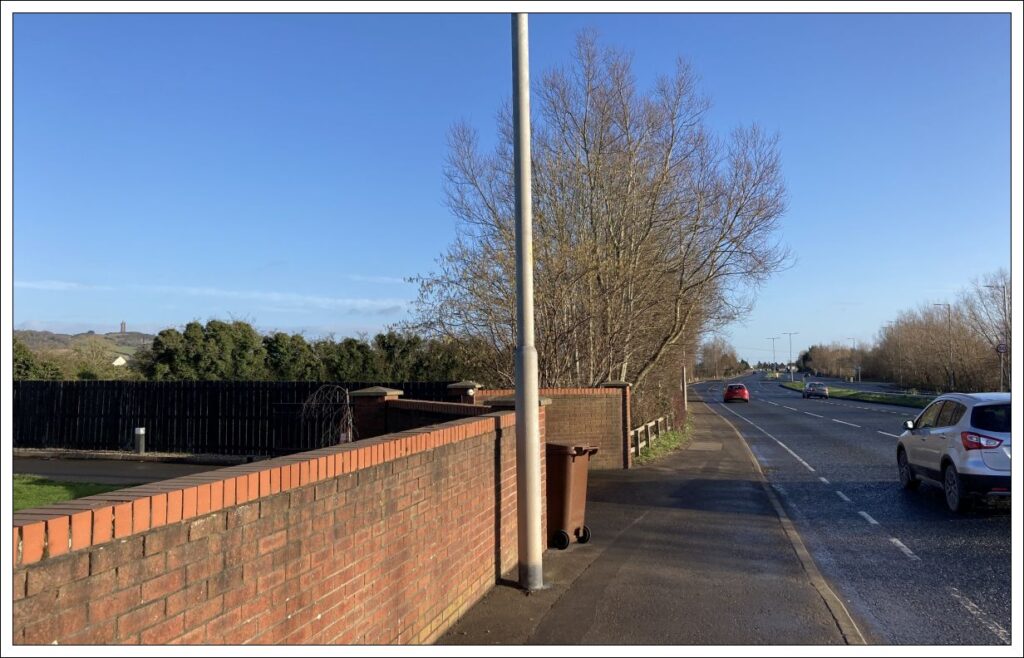
This next mile of busy roadside walking is unavoidable, but the path is good and right from the start you are treated to views of Scrabo Hill and Tower ahead to your left.
Now on this walk we will be following a ghost – the former way of the Comber to Donaghadee branch line of the Belfast and County Down Railway. The entire Comber Bypass follows the old line exactly and at the point where you just joined the dual carriageway, there once was a level crossing as the railway crossed the old road and took a diverging ruler-straight line across the field to your left towards Newtownards. Look in these fields today and all traces appear to have vanished, but as we will see later, the old way still shows if you know where to look!
The walk in 3D

The map above shows our route over the natural landscape. It also shows how this landscape has constrained and formed our manmade world over the centuries. More of this later.

As you walk look out in the hedge for an old cast iron marker. You will also come across hidden in the hedge a brown Strangford and Lecale Area of Outstanding Natural Beauty (AoNB) sign. This minor landscape designation is unfortunately as close as we get to having national parks – despite the abundance of stunning landscapes we are blessed with.

After about one mile you come across another brown sign marking the way to Scrabo Golf Club which more importantly also happens to be the way to Scarbo Country Park where we are going next.
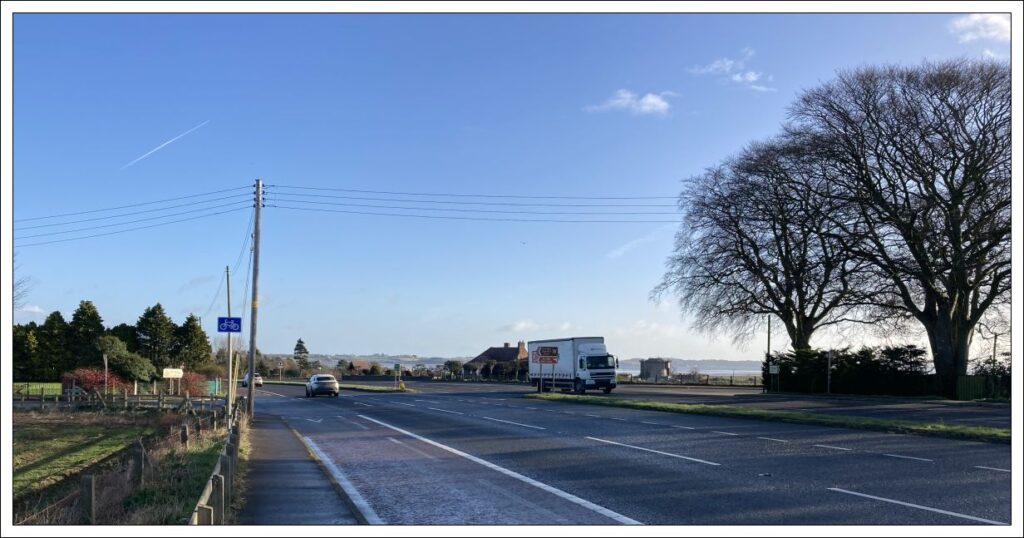
Turn left into Moate Road and proceed uphill towards Scarbo, There is no pavement on this section but traffic is light and for almost all the road visibility ahead and behind is good, except for the first bend (shown below).

Why Moate Road you might ask? Moate, half-way between moat and motte, refers to a hidden hill, now 15 feet high, in the little woodland just by the road here. The term Motte and Bailey recalls for many, school book lessons of the Norman Conquest, but like many such sites this defensive perch may be much older. Through recorded history (and long before) any high point with a view over navigable water and far approaches was prime estate for the powers that were. As you look back to the long extent of Strangford Lough and forward up to the commanding plateau of Scrabo you will see this is such a place. And for the purposes of our walk the straight way which joins two such places is a likely ancient way.
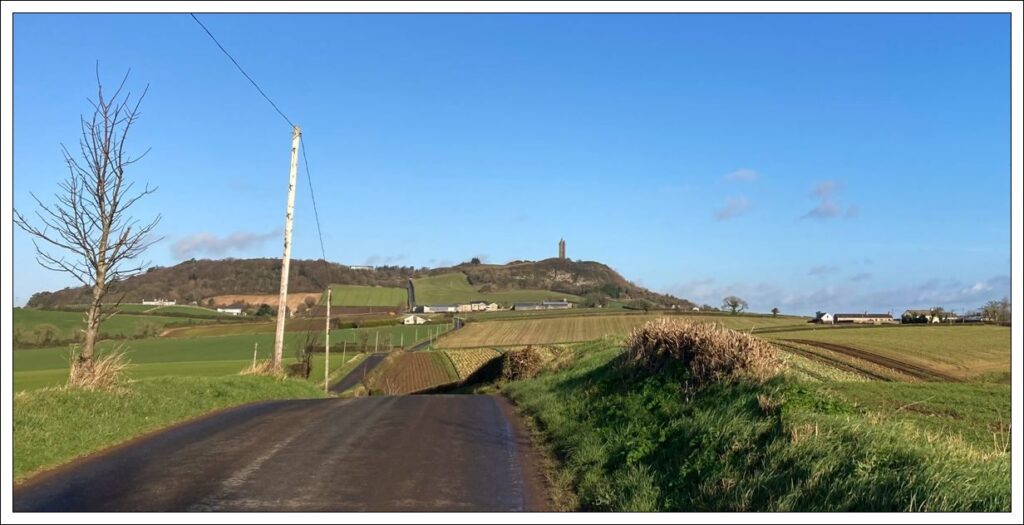
Once the first bend is passed the road stretches out ahead, dipping out of sight and rising again as it climbs a series of low ridges. After 500m in one of these dips you will pass two low stones walls each side of the road. This was and is the Ballyrickard Railway Bridge. Look to your left back towards Comber over smooth farmland this seems impossible, to your right there is a drop and a possible line of travel towards farm buildings – but hard to imagine a railway. However, continue on the road for another 100m, look back and the old railway magically comes back into view and it is easy to imagine a stream train shooting out of the fine stone archway on its way to Newtownards and the major packet port of Donaghadee.

Continue uphill, but don’t forget to look back to enjoy the growing view of Strangford Lough.

After 1km you cross the busier Scrabo Road by Alexandra House. This interesting building was once a small hotel and would not have looked out of place in any smart Victorian Spa Town. Tourism has a history here too.
Go left and immediately right to join the Scrabo Country Park access road and continue to climb for 600m to the car park, toilets and picnic area – a good place for a breather.
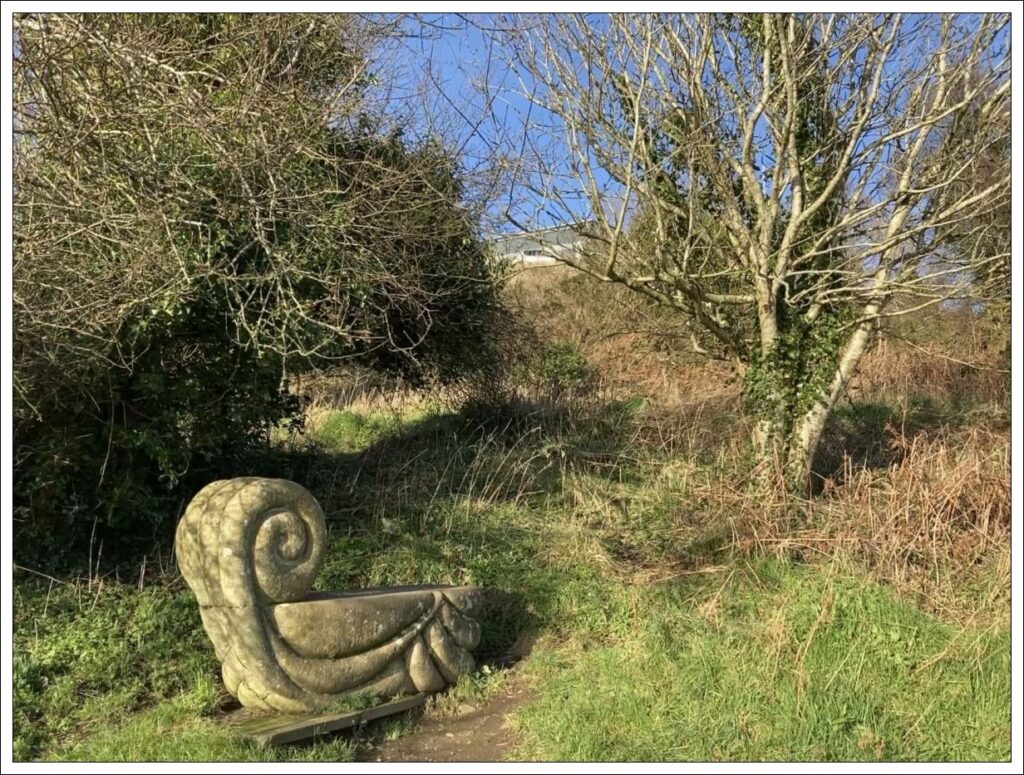

Scrabo is the first of our route’s three country parks and has arguably the best views and walking. To the west a steep network of paths run through and over Killynether Wood giving great views south to the Mournes and west towards the Belfast Hills.
The commanding plateau above and behind you is the site of one of the largest known Bronze Age Settlements in Ireland. There are also the substantial remains of an iron age 300-foot long oval fort (which now has Scrabo Tower in its centre). The dominant role of this site may even extend from pre-history into documented history, as it is very possible that Scrabo was the seat of power of the Uí Blathmac – the first recorded rulers of this area.

However, our route today heads east and up initially towards Scrabo Tower, so exit the car park and ascend the steep asphalt roadway ahead.

After 100m our route departs from the climb to the summit and Tower and we turn right, down steps and through a pleasant picnic area.
Scrabo Tower Diversion
If you have time and energy for the extra return trip of 550m and 60 feet of climb the summit and Scrabo Tower will not disappoint. However, you then must then retrace your steps back to this junction.
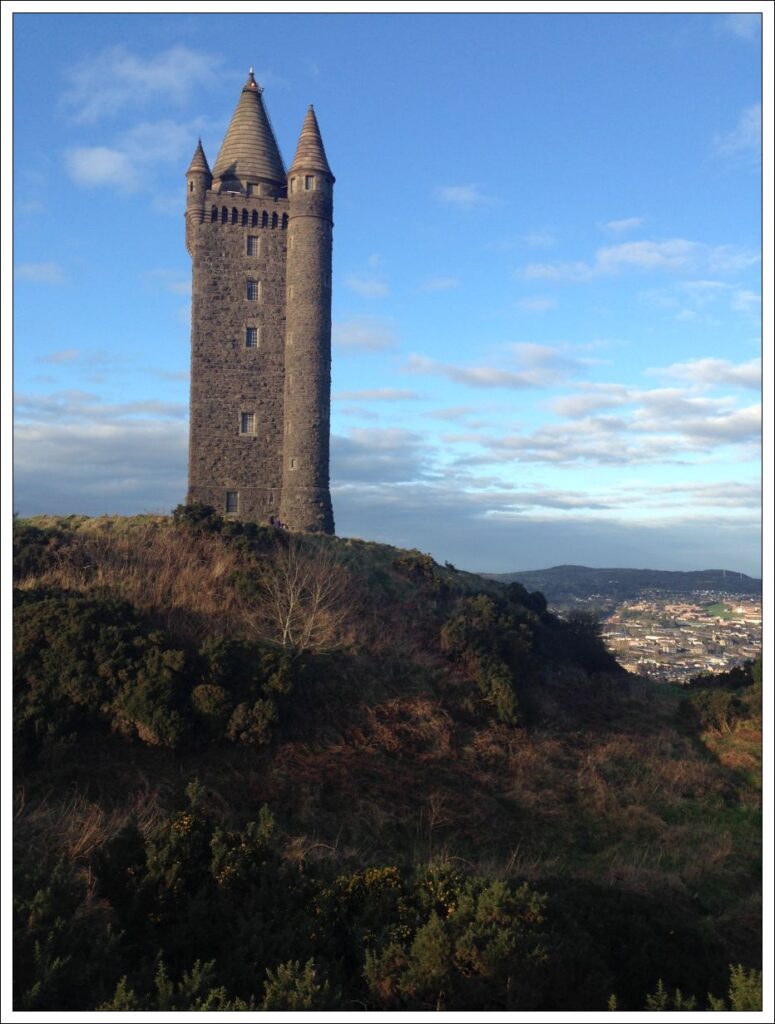
The inscriptions states that the tower was erected in 1857 in memory of the 3rd Marquis of Londonderry ‘by his friends and tenants‘. However the historical record suggests a minor input from tenants and Trevor McCavery in his meticulous history of Newtownards rather muses ‘Whenever the tenant farmer looked up, the Tower would be there, a gracious but stoney reminder of who was in charge’!
At 135 feet this tower is over twice the height of the neighbouring Helen’s Tower (60 feet). This is a very similar structure that predates it by 7 years and sits on the summit of the neighbouring Clandeboye Estate (we will pass it on part two of this route). It is hard not to imagine a degree of one-upmanship here on the part of the Londonderry family!
A word of warning for those who choose to visit the high point and may be tempted to cut a corner and descend directly towards Newtownards. Many maps do show a pathway here (including the ageing ones on the official info boards) and the Country Park once did provide such a path. However, this is long abandoned to nature and while the intrepid may be able to negotiate some of its old line, it is not to be recommended for the ordinary walker!
Main Route Continued
Descend through the picnic area exiting at the lower left hand corner following a paling-lined path along the edge of a massive abandoned quarry.
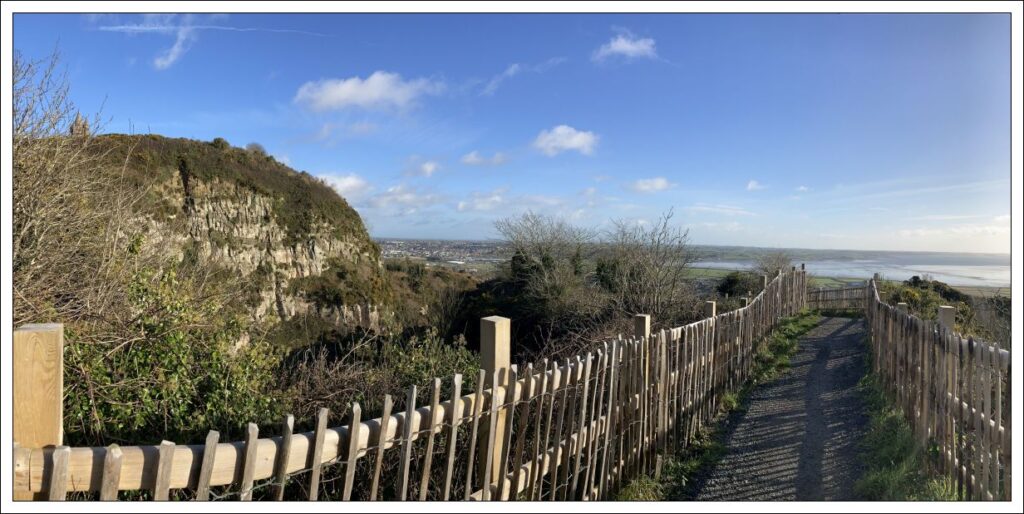
This and the chain of similar workings which we will pass below was once the source of the much-prized Scrabo stone. This fine sandstone was easy to work and very attractive and has been quarried here from at least Anglo-Norman times. The ancient monastery at Greyabbey made use of it and public and private construction continued to do so up until the last century. When we walk through Newtownards shortly we will see several fine Scrabo Stone buildings.
Today these quarries are silent apart from the call of nesting birds, and nature has softened and repurposed these amazing workings.

The path eventually levels and swings north under the line of quarries.

You soon come to a path junction where you can choose to walk into the flat floor of the first quarry. Signage here correctly points out that with cliffs there is always the possible danger of falling stone – so make your own call to visit or not.
Continuing on, the path weaves through a wooded area with large boulders scattered through the trees before levelling and running ruler-straight ahead. This is the bed of the old quarry ‘tramway’ which moved the cut stone towards the railway below.
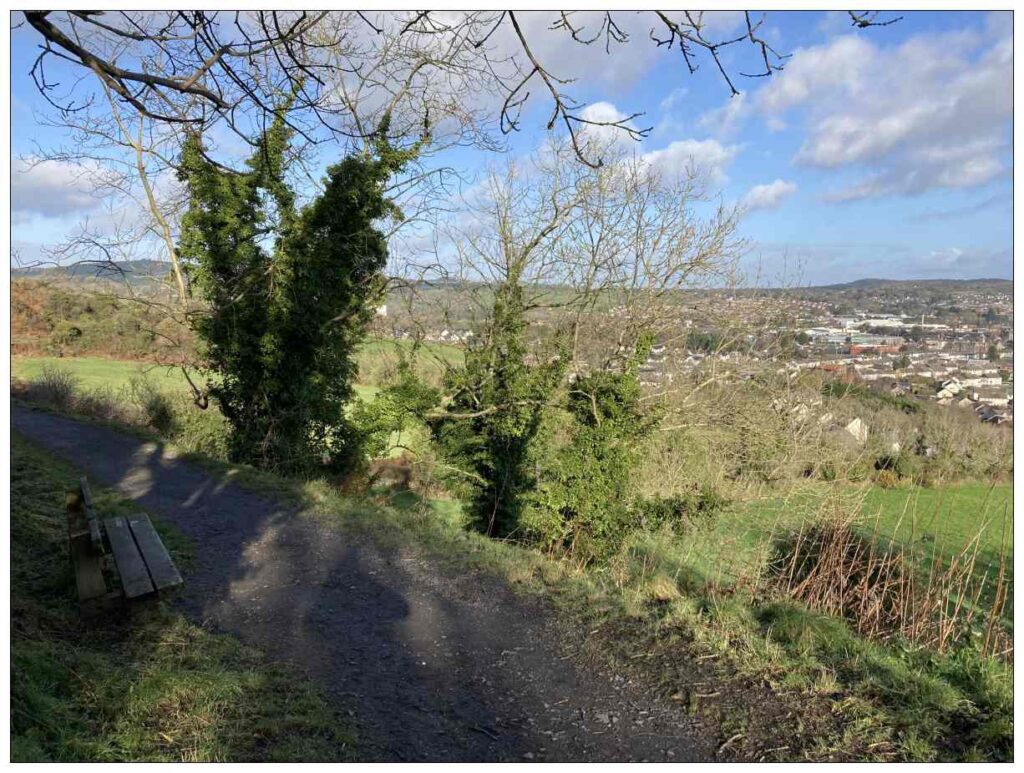
Yes – the railway appears again. Look down over Newtownards and you will see a straight wooded oversized hedge running along the edge of the built-up area. This is the path of the old railway coming into Newtownards. So how did the stone get down there from up here? The 1900 OS map gives us a clue where it shows at the north end of the quarries an ‘incline’ attached to the tramway running straight downhill via ‘Scrabo Siding’ and onto the railway – a drop of about 100 feet. Elsewhere I have seen the suggestion that this was a funicular – some form of cableway with possibly balancing counterweights. How exactly this worked I have not yet discovered – but it is on my list!
As you continue you pass three junctions where paths turn left into the strange world of the dark wooded quarries. One of these goes through a hole cut through the rock and again there are warnings about possible failing stone. The path loops here are fascinating diversions for anyone interested in the industrial history of the area – a fantastic landscape with great nature value. However, the goals of completing a long walk and exploring fully along the way are not always easily reconciled – so you may wish to leave exploration for another day.

Now back to older things. I said earlier that the Uí Blathmac people may have lived on a settlement on top of Scrabo. The other place they are associated with is Movilla where the great teaching Monastery was founded by Finnian in 540. It is recorded that Columcille (St. Columba) studied here and it is where he made an ‘illegal copy’ of the book of psalms! with dire consequences (not all scholars agree fully with this tradition).
Movilla is now completely absorbed by the suburbs of Newtownards visible from here on the higher ground to the east of the town (see map above). There was an associated settlement here, the ‘city of Mag-bile’, at a time when the low-lying ground in front of you would have been largely uninhabited. Again height and sight over Strangford Lough would have been an advantage in times when unwelcome visitors came by sea!

It was the Normans who changed everything around by creating a new settlement on the low-lying land calling it ‘Nove Villa de Blathewyc’ after the earlier custodians. This was later changed to ‘Nove Villa de Ards’ and anglicised to ‘Newtown Ards’ or Newton for short. The focus had changed from a defensive settlement to a commercial town with a market at its core. The large flat site adjacent to rich and easily cleared fertile land had many advantages, but sitting at sea level it was also hard to drain and sanitation problems would recur in its future history.
You might like to take another look at the 3D map view earlier in this post.
At the north end of the quarries the tramway joins a laneway and descends through farmland onto the old Belfast road.

This road opened in 1760 intending to provide a transport ‘bee line’ from Newtown Ards to Belfast, its line following remarkably close to the modern Dual Carriageway. Unfortunately its straight line was also a steep line, mostly unsuited to the horse-drawn wheeled vehicles of the time. It was superseded by another Belfast Road in 1817 which curves as it climbs and takes a less direct route. This was built to facilitate rapid transit from Belfast to Donaghadee, linking to the Packet Service to Portpatrick in Scotland. Until the switch to Larne – Stranraer this was the primary crossing to Scotland for passengers (and also the daily mail service).
The Romans built ruler-straight roads for marching armies on foot and horseback for whom gradient was not a problem. Also if you pay attention to lesser country roads you can still often see how the smaller older roads are straighter while those dating from the period of horse-drawn vehicles avoid height and hollow and often curve elegantly with the contours of the land. Only with the coming of the fossil-powered motor car did it become possible to return to the Roman disregard for undulations!
The Old Belfast Road has been disconnected from its former destination and is now a pleasant cul-de-sac. So turn right downhill and follow the road to the junction with Messines Road, where you turn left and then carefully negotiate the edge of the roundabout to take the third exit into Scrabo Road.
Looking ahead your eye will be drawn to a strange tower built with warm Scrabo stone. A further 300m and you will come to a fully functional primary school operating in a Jacobean style Victorian building – Newtownards Model National School.

This school was opened in 1862 as one of a network of exemplar centres of education for the ‘the promotion of united (i.e. integrated) education; improved methods of literary and scientific education; and the training of teachers‘. The curriculum included workrooms for manual instruction and ‘model farms’ both for the teaching of agriculture / horticulture practice and the production of food for the school! Unfortunately the model school programme was discontinued in the 1870s, but the school survived as a living monument to enlightened ambition in education!
Today the ‘model farm’ is long gone but the playground still has some amazing mature Chile and Scots Pines.
Continue to the next roundabout negotiating it clockwise to the second exit- Frederick Street. Now follow along past the Council Offices and turn right into Regent Street.
The broad straight boulevard made up of Church Street, Regent Street, and Francis Street was built around 1815 cutting north of the old town centre. They acted both as an early ‘through-pass’ for the mail coach and other Donaghadee bound traffic (linked directly to the newly built Belfast Road described earlier) and as an axis to build fine new buildings to showcase the town’s wealth.

Diagonally across the road junction you will see the rather fine St Mark’s Church. The NI Historic buildings database entry states:
‘Originally the church was meant to have been dedicated to either St. Finnian or St. Columba, both of whom are believed to have had important connections to Movilla Abbey‘
On Regent Street you will pass another notable building with an educational history – Regent House. However, unlike the Model School this building neither started out (or ended up) as a school – rather it was built as a stylish private home which later became a secondary school from 1924 to 1926 when the school moved to a new building taking the Regent House name with it! After that the building had a number of uses including a carpet shop. Today it hosts a variety of let-out ‘units’.

Continue on to where Regent Street meets North Street. This is the start of the second leg of this walk, but if you have the time I suggest visiting the directly adjacent Conway Square which is, in a very real sense, the crux of New Town Ards!
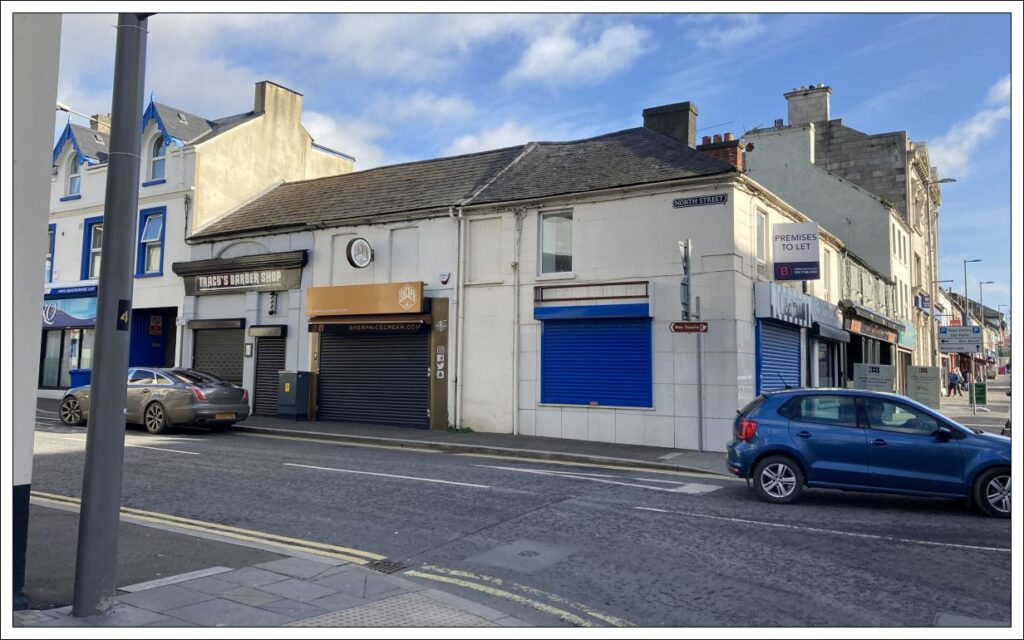
Conway Square

The building of Conway Square and its surrounding cruciform streets in around 1770 marked a new beginning for Newtownards, indeed almost another new town. The market was moved here from beside the 1636 market cross (which still stands) at the end of High Street to the south-east and a grand new Market House with Assembly Rooms was built to oversee the grand square.
South Street ran straight from here back to Comber. North Street exited the square through an arched gateway in the market house (lined with prison cells) and ran dead straight for 1 mile into the heart of the Whitespots uplands. The locations of the apparently missing West and East Street we will discover in part 2 of this route!
The founding father of Methodism, John Wesley, visited the town regularly in this period. However the fine new buildings get no mention – instead he writes:
‘deary Newtown.. More ruined than ever and very ruinous even by Irish Standards’
John Wesley quoted in ‘Newtown – A History of Newtownards’ by Trevor McCavery
McCavery points out that his focus was more likely on dwellings of the common inhabitants located out of sight on the ill-drained and crowded back streets. Wesley – like a later day Columbanus travelled widely preaching without concern whom he might offend!
Route Maps to Download and Print (PDF)
- Columban Way (via old Ulster Way) – Comber to Bangor
- Columban Way (via old Ulster Way) – Comber to Newtownards
- The Hills of Newtownards
External links
- Scarbo Tower (Wikipedia)
- Newtownards Airport (Wikipedia)
- Scrabo Stone
- Historic Environment Map Viewer (Department of Communities)
Sources
- Newtown – A History of Newtownards, Trevor McCavery, White Row 2013
